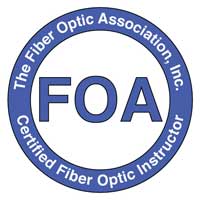
KSAs For FOA Certified Fiber Optic Instructors
KSAs for CFOS/I Instructors
The ability to perform any job requires certain knowledge, skills and abilities, commonly referred to as “KSAs.” For the fiber optic instructor, these KSAs have been determined from over 30 years of experience in actual training. The FOA has developed this list to provide training organizations and instructors a list of topics that are included in a basic training curriculum for FOA certification and special knowledge and skills expected from instructors. For those teaching in the field, it is a list of technical topics that they must understand and be able to communicate to their students and basic requirements for their role as instructor.
Knowledge
About The FOA
What is the FOA?
FOA services to the fiber optic industry
FOA free resources (website, videos, standards, etc.)
The value of FOA certification
Safety rules
Technical
Fiber Optic Jargon
Fiber optic terms
Metric System
Fiber Optic Communications Systems
How communications systems use light to transfer information
Components and their functions in a datalink
Sources: LED, Laser (FP, DFB, VCSEL)
Detectors (photodiode, APD; Si, Ge, InGaAs)
What determines how well a datalink transmits data
Optical Fiber
Types of optical fiber
SI MM , GI MM, SM
Basic specifications that affect transmission
Attenuation, dispersion
Choosing the appropriate fiber for the system
Fiber Optic Cable
Types of cables and their applications
Tight buffer (simplex, zipcord, distribution, breakout)
Loose tube (loose tube, ribbon)
Specialty (OPGW)
Relevant specifications for applications
Water blocking, pulling strength, armoring, etc.
Choosing the proper cable
Termination and Splicing
Uses
Relevant performance
Loss, reflectance, strength
Splicing Processes
Mechanical
Fusion
Mass (ribbon) fusion
Hardware
Termination
Connector types
ST, SC, LC, MTP, etc.
Termination processes
Adhesive (epoxy, anaerobic, HotMelt)
Prepolished splice
Prefab systems
Hardware
Testing
Microscope inspection
Visual tracing and fault location
Insertion loss testing
OTDR testing
Long haul SM testing for CD and PMD
Fiber Optic Network Design
Evaluating communications system requirements
Designing the proper cable plant
Layout
Choosing components
Loss budgets
Documentation
Fiber Optic Installation
Evaluating needs based on cable plant design
Planning for the installation
Safety
Eye Safety
Tool safety
Chemical safety
Disposal of materials
Performing the installation
Documenting the cable plant
Educational
How to set realistic goals and schedules for a course
How to organize a course, create lesson plans
How to effectively use textbooks, presentations, handouts, and other curriculum materials
How to use PCs, tablets and smartphones effectively
Methods of presenting materials
How to listen for student feedback
How to judge students’ comprehension of classroom sessions
How to organize hands-on labs
How to judge students’ skills at hands-on exercises
How to handle students (esp. problem students)
Positive reinforcement of students work
Keep current Fiber Optic industry
Keep Current with codes, standards, and regulations
Skills
Technical
Fiber Optic Cable
Attaching pulling eye and rope to a cable
Pulling cable
Preparing cable for splicing or termination
Tools
Use of fiber optic tools
Keep current of new fiber optic tools
Spicing
Preparing cable for splicing
Mechanical splicing
Fusion splicing
Termination
Identifying connectors
Preparing cables for various types of termination techniques
Installation techniques for various types of connectors
Inspecting connectors
Testing
Microscope inspection
Visual tracing and fault location
Insertion loss testing
OTDR testing
Educational
Communicating with students, getting feedback
Developing curriculum
Presenting curriculum
Questioning students and evaluating feedback/answers
Evaluating student progress
Running labs efficiently
Encouraging and motivating students
Time management
Abilities
General
Good eyesight
Good hand-eye coordination
Analytical skills
Trade experience
Follow directions
Course design/program flexibility
Patience
Deal with stress
Educational
Communications
Classroom and Lab Organization
Timing
Patience
- Return To The FOA Instructor's Page
-
- Return to The FOA Home Page
(C) 2012-2016, The Fiber Optic Association, Inc.

